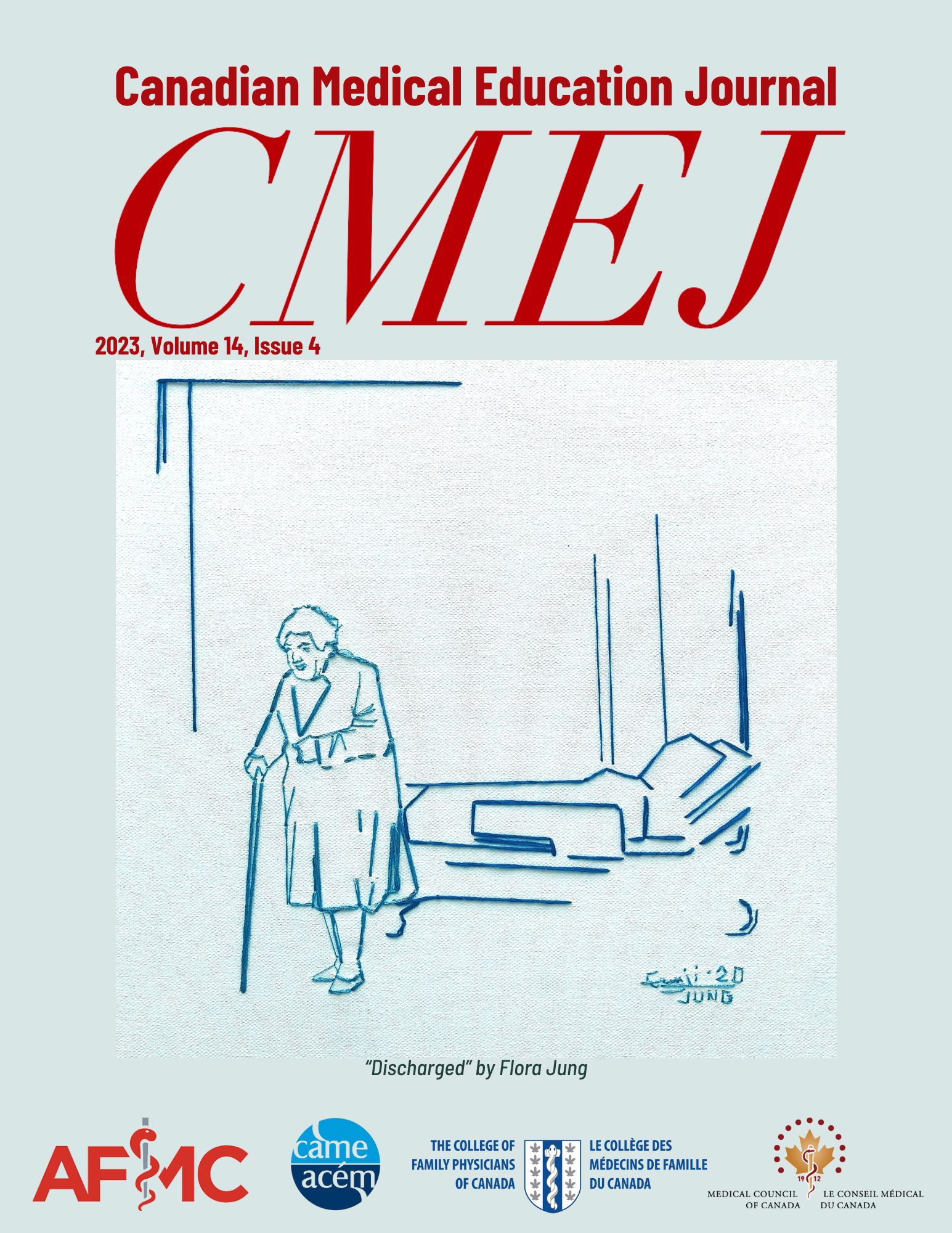Development of a bilingual interdisciplinary scale assessing self-efficacy for participating in Medical Assistance in Dying
DOI:
https://doi.org/10.36834/cmej.76161Abstract
Medical Assistance in Dying (MAiD) is a complex process involving the person seeking care and their relatives. MAiD involves physical, psychosocial and spiritual needs, and consequently the involvement of an interdisciplinary team is beneficial. Therefore, updating the knowledge and skills of healthcare and social services professionals is critical. An interdisciplinary team from Laval University (Quebec, Canada) has developed a continuous training program for all health care and social services professionals who could be involved in the care of persons who request MAiD and their loved ones. It is crucial to assess whether the objectives of the continuous training program are being met, especially since this new training addresses several complex issues (legal, ethical, and clinical). Bandura's self-efficacy theory has been widely used to develop scales for assessing the impact of training programs and identifying knowledge gaps. Bandura's theory states that feeling secure in one's self-efficacy leads to self-determined motivation. Although there are various scales intended to measure self-efficacy in palliative care, none include self-efficacy for participating in the process surrounding MAiD. As a result, we aim to create a bilingual (English-French) interdisciplinary scale to assess self-efficacy for participating in the process surrounding MAiD. The scale will allow decision-makers and researchers to identify current knowledge gaps. It will also be useful for assessing the impact of current and future training programs addressing this end-of-life practice. In this work in progress, we briefly introduce the training program and the future steps in the development and validation of the scale.
Downloads
References
Brown, J. Goodridge D, Harrison A, Kemp J, Thorpe L, Weiler R. Care considerations in a patient- and family-centered medical Assistance in Dying program. J. Palliat. Care. 2022;37,341‑351 https://doi.org/10.1177/0825859720951661 DOI: https://doi.org/10.1177/0825859720951661
Hill JE, Stephani A-M, Sapple P, Clegg AJ. The effectiveness of continuous quality improvement for developing professional practice and improving health care outcomes: a systematic review. Implement. Sci. 2020;15,23 https://doi.org/10.1186/s13012-020-0975-2 DOI: https://doi.org/10.1186/s13012-020-0975-2
Dehghani F, Barkhordari-Sharifabad M, Sedaghati-Kasbakhi M, Fallahzadeh H. Effect of palliative care training on perceived self-efficacy of the nurses. BMC Palliat. Care 2020;19,63. https://doi.org/10.1186/s12904-020-00567-4 DOI: https://doi.org/10.1186/s12904-020-00567-4
Liu L, Zhao Y-Y, Zhang L-H, Chan HY-L. Measuring self-efficacy and readiness for advance care planning in Chinese older adults. J. Pain Symptom Manage. 2020;60,622‑629. https://doi.org/10.1016/j.jpainsymman.2020.06.013 DOI: https://doi.org/10.1016/j.jpainsymman.2020.06.013
Bandura. Self-efficacy: the exercice of control. 1997; W. H. Freeman.
Phillips J, Salamonson Y, Davidson PM. An instrument to assess nurses' and care assistants' self-efficacy to provide a palliative approach to older people in residential aged care: a validation study. Int. J. Nurs. Stud. 2011;48, 1096‑1100. https://doi.org/10.1016/j.ijnurstu.2011.02.015 DOI: https://doi.org/10.1016/j.ijnurstu.2011.02.015
Desbiens J-F, Fillion L. Development of the palliative care nursing self-competence scale. J. Hosp. Palliat. Nurs. 2011;13, 230‑241. https://doi.org/10.1097/NJH.0b013e318213d300 DOI: https://doi.org/10.1097/NJH.0b013e318213d300
Terwee CB, Prinse CAC, Chiarotto A, et al. COSMIN methodology for evaluating the content validity of patient-reported outcome measures: a Delphi study. Qual. Life Res. 2018;27,1159‑1170. https://doi.org/10.1007/s11136-018-1829-0 DOI: https://doi.org/10.1007/s11136-018-1829-0
Boateng GO, Neilands TB, Frongillo EA, Melgar-Quiñonez HR, Young SL. Best practices for developing and validating scales for health, social, and behavioral research: a primer. Front. Public Health 2018;6,149. https://doi.org/10.3389/fpubh.2018.00149 DOI: https://doi.org/10.3389/fpubh.2018.00149
Collège des médecins du Québec et al. Guide d'exercice et lignes directrices pharmacologiques. 2019;226. https://numerique.banq.qc.ca/patrimoine/details/52327/3438
LeBlanc S, MacDonald S, Martin M, Dalgarno N, Schultz K. Development of learning objectives for a medical assistance in dying curriculum for Family Medicine Residency. BMC Med. Educ. 2022;22,167. https://doi.org/10.1186/s12909-022-03204-1 DOI: https://doi.org/10.1186/s12909-022-03204-1
Zamanzadeh V, Ghahramanian A, Rassouli M, Abbaszadeh A, Alavi-Majd H, Nikanfar A-R. Design and implementation content validity study: development of an instrument for measuring patient-centered communication. J. Caring Sci. 2015;4,165‑178 https://doi.org/10.15171/jcs.2015.017 DOI: https://doi.org/10.15171/jcs.2015.017
Polit DF, Beck CT, Owen SV. Is the CVI an acceptable indicator of content validity? Appraisal and recommendations. Res. Nurs. Health 30, 459‑467 (2007). https://doi.org/10.1002/nur.20199 DOI: https://doi.org/10.1002/nur.20199
Koller M, Aaronson NK, Blazeby J, et al. Translation procedures for standardised quality of life questionnaires: the European Organisation for Research and Treatment of Cancer (EORTC) approach. Eur. J. Cancer. 2007;43, 1810‑1820. https://doi.org/10.1016/j.ejca.2007.05.029 DOI: https://doi.org/10.1016/j.ejca.2007.05.029
Brislin RW. Back-translation for cross-cultural research. J. Cross. Cult. Psychol. 1, 1970;185‑216. https://doi.org/10.1177/135910457000100301 DOI: https://doi.org/10.1177/135910457000100301
Bertrand R, Blais J-GR, Bertrand J-G. Modèles de mesure : l'apport de la théorie des réponses aux items. 2004;376, 37‑69.
Polit DF, Beck CT. Nursing research: generating and assessing evidence for nursing practice. 2021. Wolters Kluwer.
Devellis RF, Thorpe CT. Scale development. 2021. Sage Publications.
Downloads
Published
How to Cite
Issue
Section
License
Copyright (c) 2023 Diane Tapp, Ariane Plaisance, Nathalie Boudreault, Isabelle St-Pierre, Jean-Francois Desbiens, Sarah-Caroline Poitras, Elizabeth Lemay, Luis Alejandro Urrea, Amélie Lapointe, Melissa Henry, Gina Bravo

This work is licensed under a Creative Commons Attribution-NonCommercial-NoDerivatives 4.0 International License.
Submission of an original manuscript to the Canadian Medical Education Journal will be taken to mean that it represents original work not previously published, that it is not being considered elsewhere for publication. If accepted for publication, it will be published online and it will not be published elsewhere in the same form, for commercial purposes, in any language, without the consent of the publisher.
Authors who publish in the Canadian Medical Education Journal agree to release their articles under the Creative Commons Attribution-Noncommercial-No Derivative Works 4.0 Canada Licence. This licence allows anyone to copy and distribute the article for non-commercial purposes provided that appropriate attribution is given. For details of the rights an author grants users of their work, please see the licence summary and the full licence.










